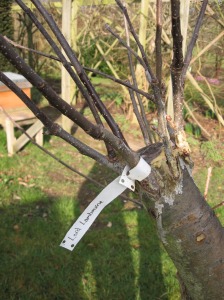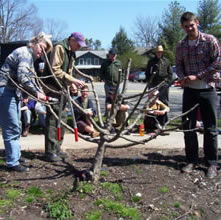
Topworking vs. frameworking
 In addition to the simple
grafts used to make new sapling fruit trees, it's worth learning about
techniques you can use to change the variety of more mature trees --- topworking and frameworking.
These related techniques can both be used to completely alter the
variety of a mature tree, or to add on a limb of a new variety when
creating a fruit
cocktail tree.
In addition to the simple
grafts used to make new sapling fruit trees, it's worth learning about
techniques you can use to change the variety of more mature trees --- topworking and frameworking.
These related techniques can both be used to completely alter the
variety of a mature tree, or to add on a limb of a new variety when
creating a fruit
cocktail tree.
So what's the difference
between topworking and frameworking? Topworking is more drastic,
removing more of the current tree (so it takes longer to recover), but
also costing less time and money. Frameworking keeps the main
branches and adds on new fruiting laterals, using scions with six to
eight buds and joining the two with stub grafting, side grafting, or
inverted L rind grafting. In contrast, topworking cuts limbs back
further and generally uses cleft grafts, oblique cleft grafts (which
Garner considers better than the former), rind grafts (if you can wait
until April when the bark slips), or strap grafts (a very good graft if
you are skilled enough to handle the complexity).
 I won't go into each kind of
grafting technique here --- I recommend you check out The
Grafter's Handbook
or peruse some extension service websites if you want to give any of
them a try. But I'll be writing about this more next spring when
I try again to change the varieties of my pear trees (this time
probably using the more appropriate frameworking).
I won't go into each kind of
grafting technique here --- I recommend you check out The
Grafter's Handbook
or peruse some extension service websites if you want to give any of
them a try. But I'll be writing about this more next spring when
I try again to change the varieties of my pear trees (this time
probably using the more appropriate frameworking).
I hope you haven't
gotten bored with all this talk of grafting, and that it's inspired you
to consider making some changes in your own orchard. We've got
several experiments on the horizon in addition to our pear
frameworking, including adding a pollinator branch to our plum tree,
trying out more apple varieties by grafting a few limbs onto our
existing trees, and grafting Asian persimmon tops onto our American
persimmon seedlings.
Do you have any grafting experiments in the pipeline?
| This post is part of our Grafting lunchtime series.
Read all of the entries: |
Want more in-depth information? Browse through our books.
Or explore more posts by date or by subject.
About us: Anna Hess and Mark Hamilton spent over a decade living self-sufficiently in the mountains of Virginia before moving north to start over from scratch in the foothills of Ohio. They've experimented with permaculture, no-till gardening, trailersteading, home-based microbusinesses and much more, writing about their adventures in both blogs and books.
Want to be notified when new comments are posted on this page? Click on the RSS button after you add a comment to subscribe to the comment feed, or simply check the box beside "email replies to me" while writing your comment.
- Remove comment
